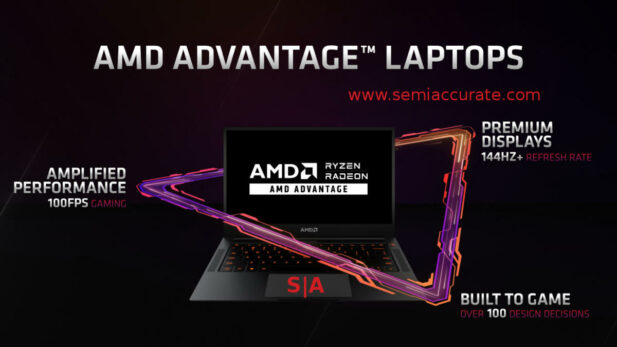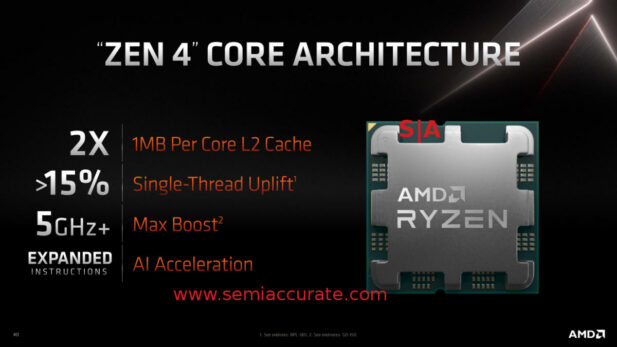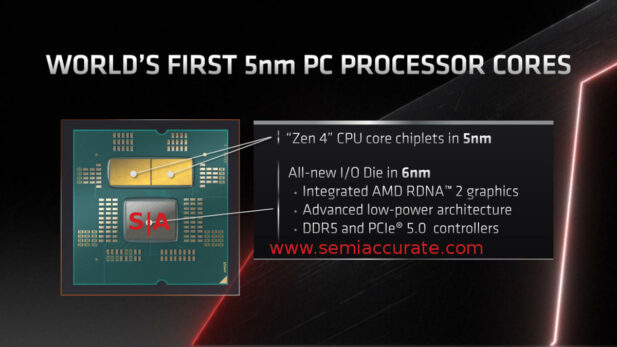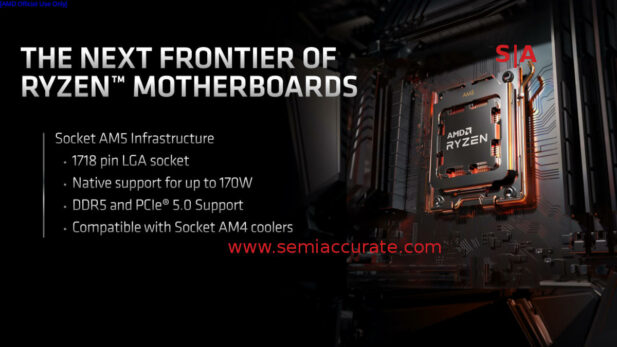 AMD’s Computex 2022 keynote had potential to be good but if you look at the numbers, it disappoints. Once SemiAccurate ran the numbers, the shine fell off the claims in short order.
AMD’s Computex 2022 keynote had potential to be good but if you look at the numbers, it disappoints. Once SemiAccurate ran the numbers, the shine fell off the claims in short order.
Normally when a company like AMD puts on a keynote, it is all glitz and glamor sprinkled with shiny new hardware. This year AMD did just that but when you stop and look at what was shown, and parse the figures, things don’t look so hot. Lets take a look at what was said and more importantly why they were said in the ways they were.
The first drum AMD beat was their success in laptops, something that is quite real. They are selling significant numbers of chips in the space and moving up the ASP ladder far quicker than Intel would prefer, especially in the corporate/’Pro’ space. This back patting is warranted because AMD is finally getting a foothold in this lucrative market, it took a long time but they are finally a real player.
Not really an advantage to buyers
Then they announced an ‘addition’ to their AMD Advantage (AA) program, basically an anti-consumer marketing program to lock out competing silicon. Like Intel’s Evo and various Nvidia kickback schemes, it uses ‘incentive’ funding and other mechanisms to ‘persuade’ OEMs to only use AMD silicon in their offerings. They have plausible deniability by making it seem like the OEM is free to choose whatever they want but realistically if the OEM does anything but what the chipmakers want, the non-subsidized devices are priced out of the market versus the compliant ones.
AMD was late to the game with Advantage but does something none of the others do, ‘enforce’ some specs that are beneficial to the user. Things like high refresh rate screens, fast storage, and more are all mandatory on AA devices. Well mandatory to use all AMD, the rest is optional with a request for a waiver, just like the Intel and Nvidia programs. That all said AMD’s program does actually try to make a better product, the other two are hard to make similar claims about.
The problem this time around is that AMD is claiming their new ‘mandatory’ feature makes gaming better, birds sing, and brings global peace that much closer. They call it Smartaccess Storage and it is nothing more than a Microsoft tech with an AMD spit shine that will be forgotten like the other 17 techs AMD introduces every generation that are useless for anything more than a headline grab. This one will be forgotten too but unlike the last few dozen, it is mandatory if you want the kickbacks. Market distortion at it’s finest, just ignore the hype around Smartaccess Storage and you will be better off.
When they stopped to take a breath, AMD claimed they would have the fastest most efficient laptop around, beating Intel etc etc. Don’t believe it, SemiAccurate thinks AMD can’t live up to the claims they make for performance and efficiency. By that we don’t mean they can’t replicate the cooked benchmarks, just that they don’t translate into the real world. (Note: If you want to test it, look no further than the slowing of clock ramps when on battery power vs Intel’s method.) AMD goes out of their way to stifle independent benchmarks, something a company that can back up their claims doesn’t do.
We say this because the last time AMD offered us samples, it was for the last gen Ryzen 5000 mobile parts, they did just that. At the last minute, AMD said to us that they would only send the sample they agreed to send if we tested with the software they wanted and ONLY with the software they wanted. If we didn’t agree to follow their rules, no sample. SemiAccurate, as per our policy, told AMD which orifice to place their request in and were promptly not sampled. For the Ryzen 6000 launch we requested a sample and the emails were not acknowledged and SemiAccurate was cut out of briefings on the products even though AMD had specifically agreed to invite us to these types of briefs in the past. Make of this what you will, but honest companies don’t even joke about this kind of thing.
The core of the matter
Then we come to the real meat of the show, the next baby step in the Socket AM5/Zen 4 reveal. Think Zen 4 cores, 5nm, and AM5 platform, all of which we knew about already. The new part were numbers and a few details like you can see above. Doubling the L2 to 1MB/core is a good thing, 15% uplift or more in single threaded apps sounds good on paper, and new AI instructions are following the obvious trend. The 5GHz+ number is sure to make headlines as well, as are the 16 cores that will have one that may hit that speed mark. More important is the fact that the socket is mechanically compatible with AM4 so coolers will carry over. This is a really good thing.
Finally a new IOD
The Zen 4 cores in 5nm has been known for a while but the IOD in 6nm confirms what was long suspected. The biggest surprise of the day however was that AMD is putting RDNA2 GPU cores on the IOD so this generation of multi-chip Ryzens will have integrated graphics. We aren’t sure if this is a good idea for the high end gaming parts but it will give AMD a lot of flexibility on the lower end of the stack.
AM5 gets some specs
AM5 is now officially listed as 1718 pins and moves to an LGA form factor, something that was long overdue. As we previously mentioned, the physical compatibility with the older socket mechanicals is more impressive with the change in pin type. What probably matters most is the increase in power delivery to 170W, up from the 140W of the AMD socket, a >20% increase in headroom. This isn’t good or bad, it just is and gives users more flexibility but will make boards cost a little more too.
There are three chipsets that will come with the CPUs and platform, the X670 Extreme, X670 less Extreme, and the B650. The big EXXXXXTRemE!!! one has up to two PCIe5 GPU slots and one PCIe5 storage slot, up to 14 USB3 20Gbps ports, up to four DP2/HDMI2.1, and WiFi 6E. AMD was a little vague on how many USB slots support what speeds but there should be enough for most in the pimptacular boards that will undoubtedly appear.
One big issue is that those two PCIe GPU slots are not going to be 16x because 16x * 2 is more than the 24 lanes the CPU has even before you subtract two or four for the mandatory PCIe5 storage slots. This means the slots have no more bandwidth than a PCIe4 16x slot that costs significantly less to make a motherboard for. Given the length of time AM5 will live for, AMD just waved a flag that this platform is going to be hobbled before it comes out, no dual 16x slots on AMD anymore and higher costs for no net gain. Why?
The non-ExxxxTreeeme X670 chipset has optional PCIe5 for GPUs, and only one slot at that but PCIe5 for storage is mandatory. Stepping down to the B650, only PCIe5 for storage is mandatory. Can you see what AMD wants to promote this time around? Hint: The next few slides talked about their partnership with Phison and others for PCIe5 SSDs, and remember that AA mandatory feature earlier? Not by chance. Good luck with battery life on this front though, there is a reason Intel fused of PCIe5 on their first gen Alder Lake mobile devices.
Overall the details of the AM5 platform are a letdown. Other than the mechanical compatibility, AMD is going down the route of stupid segmentation that lead Intel to heightened EOM enmity and market confusion. The delineations they make for the chipsets seem artificial and arbitrary, any potential cost savings by avoiding PCIe5 on the GPU side are blown away by the mandatory PCIe5 storage slots. Nothing is bad, just that the clear as mud breakpoints don’t help anything so why do it?
Now back to our point about digging into the numbers. If you look at the breathless claims about the new Zen4 devices, Lisa Su even showed one running with a peak core clock, peak single core clock mind you, of 5.5GHz. Couple this with the claimed, “>15% Single-Thread Uplift” from the slide above and you have a monster, right? That is what they want the headlines to read, but lets take a look at the real numbers.
Starting out we will round figures here and there for ease starting with that 5.5GHz claim, lets call it a potential 10% clock increase. It is for one core but we are looking at single threaded performance so that caveat is mostly irrelevant. That >15% figure was also directly stated as from a combination of IPC and clock. If you take out at 10% clock uplift that >15% becomes a roughly >5% uplift, so lets say high single digit performance increases for the Zen4 core. This is way below the expected ~20% IPC increase number, not counting clocks.
From there you get an efficiency increase when moving from Zen3’s 7nm process to the 5nm of Zen4. This means for the same TDP the new cores should run significantly faster, nothing new here, standard shrink benefits. The problem for AMD’s numbers is that new AM5 socket ups the wattage available to the CPU by ~20%. AMD did not release any specifics on the TDP of the Ryzen 7000 line but we will go out on a limb and say that it will increase from the 105W of the current Ryzens, likely by comparable percentages to the socket power delivery increase.
That leaves us with a 5-10% IPC increase for the Zen4 cores and an open question, how much of that clock increase is due to more power? That TDP increase is also mirrored in recent server offerings, Genoa/Bergamo has been seen to go up to 440W, so efficiency doesn’t look to be the strong point of the Zen4 devices, consumer or not. When you look deeply at the numbers, this new Ryzen 7000 line doesn’t look all that hot. OK, hot may be a bad choice of words, how about “all that impressive”?
That brings us to the next reveal from AMD, the new Mendocino SoC. Take the current Zen3/3+ uncore with RDNA2 graphics and replace the cores with Zen2 ones. Build it on the same 6nm process as the big cores and… victory? AMD is aiming Mendocino at the low end of the market, $399-699 devices with Windows or Chrome. The new cores are a way to shrink the dies and save costs but AMD claims it is a performance improvement over the previous Zen2 devices but is silent on comparisons to existing offerings for the same market.
In reality it will save a few cents off the cost of the dies but to SemiAccurate Mendocino is just dumb. The meager savings aren’t worth spinning a new die for the low end of the market. Worse yet with the tightness in wafer starts on current or +1 processes, does moving a volume product from an older node to a constrained and more expensive one make sense? How many Ryzen 7000 IODs or high end Ryzen 6000 parts will this preclude to service a market with what margins again? Call us crazy but from our point of view Mendocino is not only a bad product, it comes with a high opportunity cost. Why AMD? Even a Zen3/4 Dense based device would make more sense than this.
Moving on to a happier note, AMD threw Intel’s sleazy marketing back in their faces during the keynote and it made us smile. Intel has been purposefully blurring the line between cores, threads, and value with their Alder Lake messaging, something SemiAccurate hasn’t been shy about criticizing. AMD compared their 16C Ryzen 7000 devices against an Intel ’16-core’ CPU and destroyed it. This is going to be a fun one to watch play out again and again over the next year or so, and we will keep smiling. Comeuppance is a dish best severed via recorded keynote or something like that.
Last up we have the worst part, the upcoming Ryzen 7000 line and likely Mendocino are not safe to use. They all contain a remotely exploitable hardware backdoor that can not be turned off. Actually you can flip a BIOS switch that says off but if you do, Windows won’t run. On top of that since it is the block that brings the system up, if it is actually off, not just listed as such in the BIOS, the system can’t post so ‘off’ means nothing. In SemiAccurate’s opinion, these CPUs are too insecure to use, and that is sad to say.
Where does this leave us? Not in a good place. AMD makes claims about laptop performance and efficiency and then goes out of their way to shut down independent testing in the least ethical way SemiAccurate can think of. The new AM5 socket looks good but marketing decisions make us wary on non-technical fronts, we hope AMD doesn’t go down the Intel path to ruin over this. Based on the numbers AMD put out, the Zen4 cores underperform expectations by a lot, lets hope there is upside when the real numbers are revealed later this year. One thing we don’t expect any up side on is Mendocino, a self-inflicted opportunity cost wound that we can’t justify on any front. What seemed like a good keynote didn’t hold up when you look at what was actually said rather than parroting back the talking points. What is going on at AMD?S|A
Charlie Demerjian
Latest posts by Charlie Demerjian (see all)
- Qualcomm Is Cheating On Their Snapdragon X Elite/Pro Benchmarks - Apr 24, 2024
- What is Qualcomm’s Purwa/X Pro SoC? - Apr 19, 2024
- Intel Announces their NXE: 5000 High NA EUV Tool - Apr 18, 2024
- AMD outs MI300 plans… sort of - Apr 11, 2024
- Qualcomm is planning a lot of Nuvia/X-Elite announcements - Mar 25, 2024



